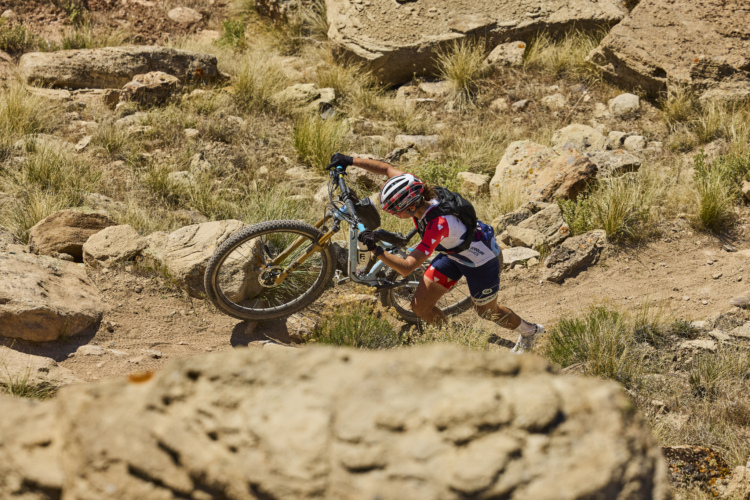
Shimano XT brakes need no introduction. For many riders, loyalty to the brand’s mountain bike stoppers runs deep. While bikes may come and go, fans stick to XT brakes for the power, consistent performance, and quick bite. The latest 4-piston XT brake set, officially designated BR-M8120, boasts a few notable tweaks and improvements as I’ve discovered over the past several months of testing.
Shimano XT BR-M8120 Specs
- Price: $229.99 per brake (rotors not included).
- Buy from Jenson USA and other retailers
Shimano XT 8100-series brakes are available in 2- and 4-piston versions (I tested the latter), and feature a painted aluminum body and ceramic pistons. My test set shipped with finned, metallic pads and all XT brakes utilize mineral oil in the hydraulic system.


Shimano says the current crop of XT brakes offers 10% more power than the last one, and they are quieter to boot. The brand also claims the latest design results in quicker piston retraction when it’s time to let go of the levers.
Rather than trying to weigh the brakes for myself (without the hose? with pads? do caliper bolts count?) I’ll go with Shimano’s estimate of 410g, on average.
The M8000 lever I tested is I-Spec II compatible and features both free stroke and tool-less reach adjust.


Shimano XT Brakes Installation
Installing the Shimano XT brakes went off without a hitch. The brake hose comes pre-bled and attached at the caliper, leaving only the connection at the lever to the buyer. A simple banjo-style connector makes attachment easy, and an extra barb and olive are included in the box in case the hose needs to be shortened. I didn’t find it necessary to bleed the brakes immediately after installation, though this may not be the case for every install.

Shimano recommends pairing the XT brakes with 800-series rotors, so I locked on a set 180mm Ice Tech Freezas. As a part of the XT component series, these brakes are designed with trail riding in mind. Out of the box the brakes are designed to fit 160mm rotors, though they are compatible with any diameter from 140mm to 203mm with the right adapter.
Aligning the calipers took very little effort: just spin the wheel, grab the brake lever, and wrench the bolts in place. After the initial set up, I haven’t had to make any alignment tweaks.
The lever mounts easily to the handlebar thanks to the open clamp band. Naturally these work well with a Shimano shifter for a nice and neat bar setup.
XT Brakes On the trail
Listen to any group of mountain bikers debating brake choices, and aside from talking about power, much of the discussion will revolve around modulation. Some riders prefer a more on/off feel, while others like to have a progressive range to feather along the trail. To be clear, it’s not that one is better than the other; like many things, modulation comes down to personal preference and riding style. Along the brake action spectrum, most riders tend to place Shimano brakes on the on/off side of center, and that seems to be a fair assessment.
That’s all a long wind up to say that these latest Shimano brakes appear to have shifted closer toward the center of the modulation spectrum. Compared to previous models of XT brakes, these feel more nuanced and yet as powerful as ever. Sure, you can still lock up the back wheel with a quick tug of the lever, or flip yourself over the bars with a short pull on the front brake, if that’s what you want. You can just as easily scrub the right amount of speed to land that double smoothly or to roll into that berm without wasting a second of time. For those used to the old XT brakes, these may require a slight adjustment period, though in the end, it should be worthwhile thanks to increased overall stopping power.

The M800 rotors are surprisingly lightweight in the hand, officially tipping my scale at 132.8g. Though Shimano claims the M8120 system “reduces disc brake rotor wobbling noise,” I can definitively say the design has not eliminated noise. After particularly wet creek crossings these can be downright loud, though to be fair, they’re no louder than any other mountain bike brakes I’ve tested.
Shimano’s other claim, that the updated XT brakes offer quicker piston retraction, is a hard one to test. I suspect the updated and more progressive braking action is due in part to the ability for the caliper to glide more freely along its path, rather than sticking or stuttering along the way. Quicker retraction hints at a more fluid system with less resistance, which should also bode well for durability and lower maintenance over time.


The stock Shimano XT brake lever is a bit shorter than what I prefer, though that’s more of a personal preference. The tool-less reach adjust does make it easy to find the best position, and the free-stroke adjustment allows further customization for just the right feel.
Testing these brakes on long descents I found less noticeable fade than with others. Shimano’s design places a premium on heat dissipation, and the upshot is consistent braking from the top of the mountain to the bottom, and (hopefully) fewer bleeds over time.


Overall
The latest Shimano XT brakes should satisfy most trail riders, though diehard fans of the line might need a little coaxing to appreciate the updates. With dependable performance plus easy set-up and maintenance, XT brakes are still the ones to beat.
- MSRP: $229.99 per brake (rotors not included).
- Buy from Jenson USA and other retailers







